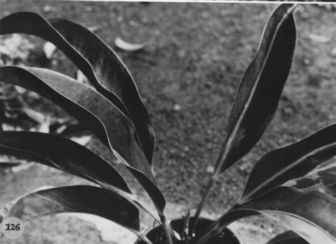




Anthurium paludosum Engl.,
Bot. Jahrb. Syst. 25: 401. 1898. TYPE: Colombia. Valle: near Buenaventura, Lehmann 3811 (B, holotype).
Epiphyte; stems to 30 cm long; roots numerous, grayish-green, smooth, descending; cataphylls coriaceous, 5-6 cm long, persisting ± intact, drying brown, ultimately deciduous.
LEAVES spreading-pendent; petioles 3-14 cm long, 3-5 mm diam., D-shapcd to subterete, broadly and obtusely sulcate; geniculum 1-1.5 cm long; blades narrowly elliptic to oblanceolate, subcoriaceous, 10-38 cm long, 3-13.5 cm wide, short-acuminate at apex, acute to attenuate (rarely obtuse to subrounded) at base; both surfaces semiglossy, sparsely punctate; midrib convexly raised above and below, sunken at apex above; primary lateral veins 12-14 per side, departing midrib at 40° angle, sometimes weakly sunken, usually ± obscure on upper surface, prominulous on lower surface; collective vein arising from the base and extending ± straight to apex, 3-12 mm from margin, flat and nearly obscure on upper surface, prominulous on lower surface.
INFLORESCENCE erect-spreading, shorter than leaves; peduncle 7.5-15.5 cm long, 3-5 mm diam., terete, tinged red-violet; spathe moderately thin, whitish to green or purplish, withering soon after anthesis, oblong-lanceolate, 5.5-7 cm long, 4-14 mm wide, acuminate at apex, rounded at base, inserted at ca. 60° angle on peduncle; spadix green, tinged orange, becoming violet-purple, 8-14.5 cm long, 6-7 mm diam. at middle, scarcely tapered at apex; flowers rhombic, 2.8-3.2 mm long, 2.5-2.7 mm wide, the sides straight or weakly sigmoid; 5-6 flowers visible in the principal spiral, 7-9 flowers visible per alternate spiral; tepals matte to semiglossy, tinged violet-purple at outer margins, lateral tepals 1.9-2 mm long, the inner margin broadly rounded; pistils green, weakly emergent; stigma linear; stamens emerging from base, the lateral stamens emerging with only the apex of the anther visible, retracting before alternate stamens emerge, leaving only traces of white pollen.
INFRUCTESCENCE with spadix 6-25 cm long; berries orange, red-orange,
or white tinged with orange, ± globose to ovoid, 4-6 mm diam.; seeds
3-4, ellipsoid-oblong; 2-2.5 mm long, yellowish, except green on one end.
Fig. 126.
Anthurium paludosum is known from Costa Rica to Colombia at elevations
from sea level to 400 m. It ranges along the Atlantic slope only west of
the Isthmus of Panama. To the east of the Isthmus of Panama it occurs on
both slopes until reaching South America, where it is restricted to the
Pacific slope. The species occurs in wetter parts of tropical moist forest
and premontane wet and tropical wet forest life zones. Anthurium paludosum
is a member of section Porphyrochitonium and is recognized
by its coriaceous, almost oblong leaf blades that are more or less the
same color on both sides with a pale green midrib on the upper surface,
and by its thick, persistent, nondilaceraling cataphylls and reddish-orange
berries. No other species in this section is known to have cataphylls that
remain intact.
In the revision of the Costa Rican Anthurium (Croat & Baker,
1979), A. eggersii Engl. was included as a synonym of this species,
but examination of the type now precludes that possibility because that
species has prominently dilacerating cataphylls. In other respects the
two species appear to be markedly similar.
 |
Map of Mesoamerican specimens with coordinates
Costa Rica Lim—n: 1-10 m, 09.38N 82.39W, 4 Nov 1984, Michael Grayum,
Willie Burton & Ernesto Salazar 4366 (MO).
Costa Rica Lim—n: 0 m, 09.35N 82.36W, 29 January 1987, Michael Grayum,
Bill McLarney & Fred Field 8039 (MO).
Costa Rica Lim—n: 280 m, 9.29.50N 82.59.10W, 4 July 1989, Gerardo Herrera
3134 (MO).
Panama :, , Kamemoto 309-1 (AAU, CAS, NY, OOM, US).
Panama Bocas del Toro: 590 m, 8.46N 82.14W, 10 March 1985, T.B. Croat
& M.H. Grayum 60198 (MO).
Panama Canal Area:, 8 Mar. 1971, Thomas B. Croat 13989 (MO).
Panama Chiriquí: 80 m, 8.50N 82.10W, 9 March 1985, T.B. Croat &
M.H. Grayum 60089 (MO).
Panama CoclŽ: 200-400 m, 8.45N 80.35W, 4 Feb. 1983, C. Hamilton &
G. Davidse 2706 (MO).
Panama CoclŽ: 700 m, 8.47N 80.28W, 11 Dec. 1983, H.W. Churchill, A.
Lier, W.S. Armbruster & A. Herzig 4075 (MO).
Panama Panamá: 200-250 m, 9.15.00N 78.59.00W, 30 Mar 1988, Thompson
4643 (CM).
Panama San Blas: 300-350 m, 9.15N 79.00W, 12 July 1988, Thomas B. Croat
69285 (MO).
Panama San Blas: 300-350 m, 09.15N 79.00W, 27 March 1987, Gordon McPherson
10763 (MO).
Panama San Blas: 50-150 m, 9.24N 79.08W, 27 Jan 1985, Greg de Nevers
4685 (MO).
Panama San Blas: 350 m, 9.19N 78.55W, 20 Nov. 1984, Greg de Nevers
& H. Herrera 4357 (MO).
Panama San Blas: 350 m, 9.19N 78.55W, 2 Nov. 1985, Greg de Nevers,
H. Herrera & S. Charnley 6135 (MO).
Map of South American Specimens with coordinates
Colombia Choco: 100 m, 5.14N 76.40W, 15 April 1983, Thomas B. Croat
55974 (JAUM, MO).
Colombia Choco: 70 m,, 8 Sept 1976, Forero & Jaramillo 2692 (COL,
MO).
Colombia Choco: Río Baudó Región,, 2 Feb-29 Mar
1967, Fuchs et al. 21869 (COL, US).
Colombia Choco: Río Baudó Región,, 2 Feb-29 Mar
1967, Fuchs et al. 22083 (COL,US).
Colombia Valle del Cauca: 150 m, 04.02N 77.04W, 17 July 1993, Thomas
B. Croat & Dorothy Bay 75804 (MO).
Colombia Valle del Cauca: Bajo Calima, 50-80 m, 3.56.00N 77.7.30W,
19 July 1988, Thomas B. Croat 69412 (MO).
Colombia Valle del Cauca: Bajo Calima, 40.03N 77.08W, 5 February 1990,
Thomas B. Croat & Jonathan Watt 70234 (MO).
Colombia Valle del Cauca: near sea level,, 2 June 1944, Killip &
Cuatrecasas 38646 (COL).
Colombia Valle del Cauca: 150 m,, , Maas & Plowman 1950 (GH).
Colombia Valle del Cauca: Bajo Calima, 50 m, 03.56N 77.08W, 16 Feb
1983, Al,Gentry, A. Juncosa, H. Mazuera & W. Ladrach 40406 (COL, MO).
Colombia Valle del Cauca: 5 m,, 05 febrero 1990, W. Devia A., R. Bernal
y E. Linares 2943 .
Colombia Valle del Cauca: Río Dagua, 40 m,, 15 Feb. 1939, Killip &
Garcia 33334 (COL).